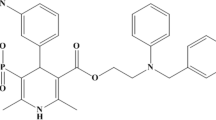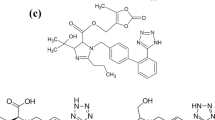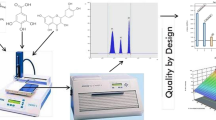Summary
The ion-pair liquid-chromatographic separation of the water-soluble vitamins thiamine mononitrate, riboflavin phosphate, nicotinamide, pyridoxine hydrochloride, ascorbic acid, saccharin, and the dye Sunset Yellow FCF (E110) has been examined for the analysis of the compounds in effervescent tablets. A Draper-Lin small composite design was used to study the impact on the compounds' retention times and peak-widths (the response variables) of four different mobile phase variables: percentage of methanol as organic modifier, the concentrations of hexanesulfonate as ion pairing reagent and of triethanolamine as competitive base, and pH. The interactions of these variables were also studied. The proposed design enabled derivation of multiple linear regression equations to model each compound's retention time and peak-width at half-height. The statistical reliability of the regression models was established by comparing predicted and experimental values. By introducing the regression models into a spreadsheet program (Excel 5.0), retention times and peak-widths for each compound were calculated at fixed mobile phase pH. The values of all the other combinations of the three mobile phase variables were changed in increments of two units within their examined boundaries, resulting in 225 different rows. For each combination the compounds' calculated retention times and their corresponding peak-widths were sorted in increasing order and the resolution between successive peaks was calculated. The minimum effective resolution (R s min) between each pair of peaks and the maximum retention time (t R max) in each row were then selected and used to construct contour plots indicating the location of zones of mobile phase parameter combinations whereR s min>1.5 and the analysis was rugged, and wheret R max values were minimum. Their common regions resulted in optimum chromatographic separations. Examples are shown of chromatographic separations obtained using mobile phase combinations which were the best compromise of the three criteria selected.
Similar content being viewed by others
References
A. Albert, E. P. Serjeant, “The Determination of Ionization Constants, A Laboratory Manual”, 3rd edn, Chapman and Hall, USA, 1984, p. 167.
N. R. Draper, D. J. K. Lin, Technometrics27, 173 (1985).
N. R. Draper, D. J. K. Lin, Technometrics32, 187 (1990).
S. N. Deming, S. L. Morgan, “Experimental Design: A Chemometrics Approach”, Elsevier, Amsterdam, 1993, p. 246.
G. E. P. Box, N. R. Draper, “Empirical Model Building and Response Surfaces” John Wiley and Sons, Inc., New York, 1987, pp. 502–525.
G. E. P. Box, K. B. Wilson, J. Roy. Statist. Soc. Ser. B13, 1 (1951).
G. E. P. Box, W. G. Hunter, J. S. Hunter, Ann. Math. Stat.28, 195 (1957).
D. L. Massart, B. G. M. Vandeginste, S. N. Deming, Y. Michotte, L. Kaufman, in “Chemometrics: A Text Book”, Elsevier, Amsterdam, 1988, p. 101.
G. Sado, M. C. Sado, “Les Plans d'Expérience; de l'Experimentation à l'Assurance de Qualité,” Afnor Technique, Paris, 1991, p. 70.
G. E. P. Box, W. G. Hunter, J. S. Hunter, in “Statistics for Experimenters, An Introduction to Design, Data Analysis and Model Building”, John Wiley and Sons, Inc., New York, 1978, p. 327.
G. E. P. Box, W. G. Hunter, J. S. Hunter in “Statistics for Experimenters, An Introduction to Design, Data Analysis and Model Building, John Wiley and Sons, Inc, New York, 1978, p. 309.
M. A. Allus, R. G. Brereton, G. Nickless, Chemometr. Intell. Lab. Syst.3, 215 (1988).
M. A. Allus, R. G. Brereton, G. Nickless, Chemometr. Intell. lab. Syst.6, 65 (1989).
L. R. Snyder, J. Glajch, J. Kirkland, Practical HPLC Method Development, John Wiley and Sons, Inc., New York, 1988, p. 17.
E. Morgan, K. W. Burton, P. A. Church, Chemometr. Intell. Lab. Syst.5, 283 (1989).
J. O. De Beer, C. V. Vandenbroucke, D. L. Massart, J. Pharm. Biomed. Anal.12, 1379 (1994).
J. O. De Beer, C. V. Vandenbroucke, D. L. Massart, B. M. De Spiegeleer, J. Pharm. Biomed. Anal.14, 525 (1996).
F. Rouberty, J. Fournier, Chromatographia41, 553 (1995).
Author information
Authors and Affiliations
Rights and permissions
About this article
Cite this article
Nsengiyumva, C., De Beer, J.O., Van de Wauw, W. et al. An exprimental design approach to selecting the optimum liquid chromatographic conditions for the determination of vitamins B1, B2-phosphate, B3, B6 and C in effervescent tablets containing saccharin and sunset yellow FCF. Chromatographia 44, 634–644 (1997). https://doi.org/10.1007/BF02466667
Received:
Revised:
Accepted:
Issue Date:
DOI: https://doi.org/10.1007/BF02466667




